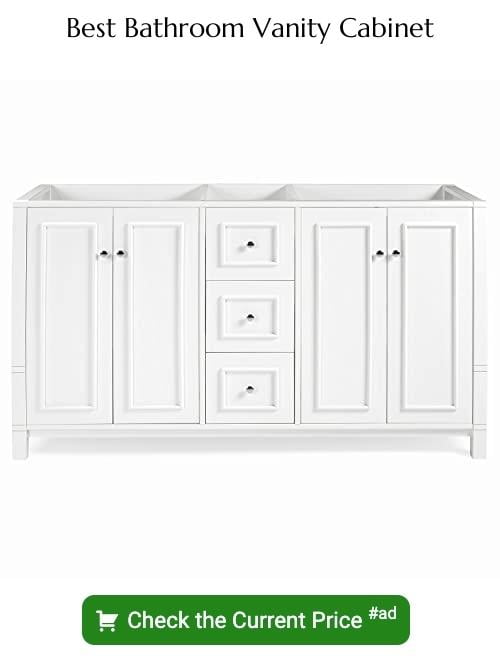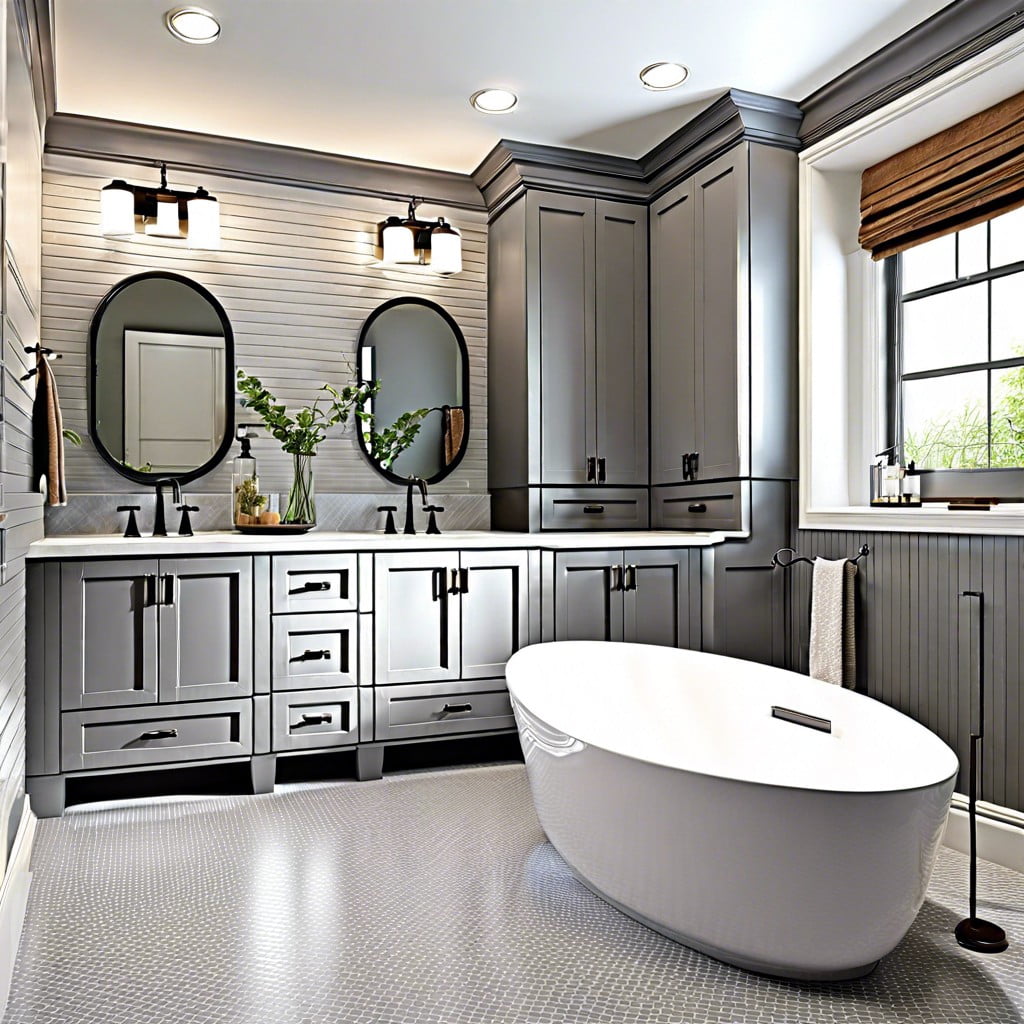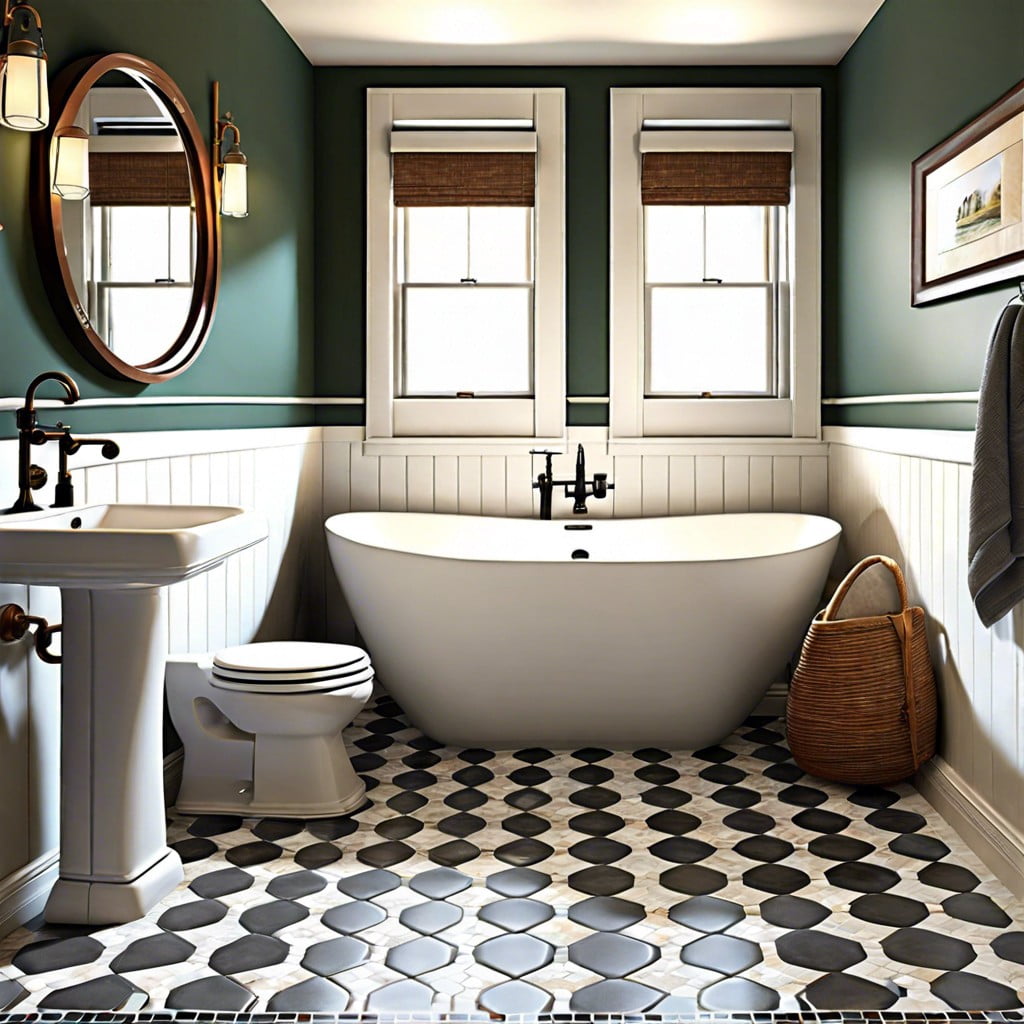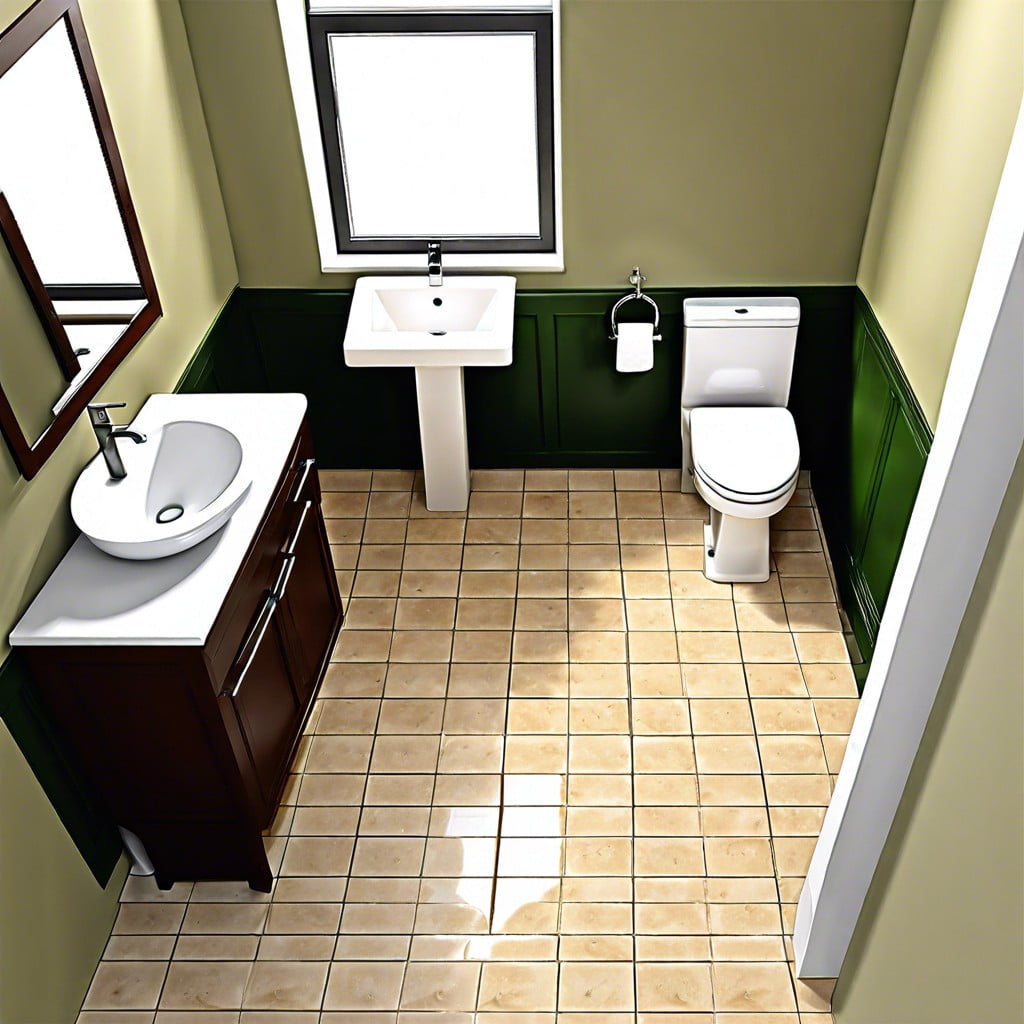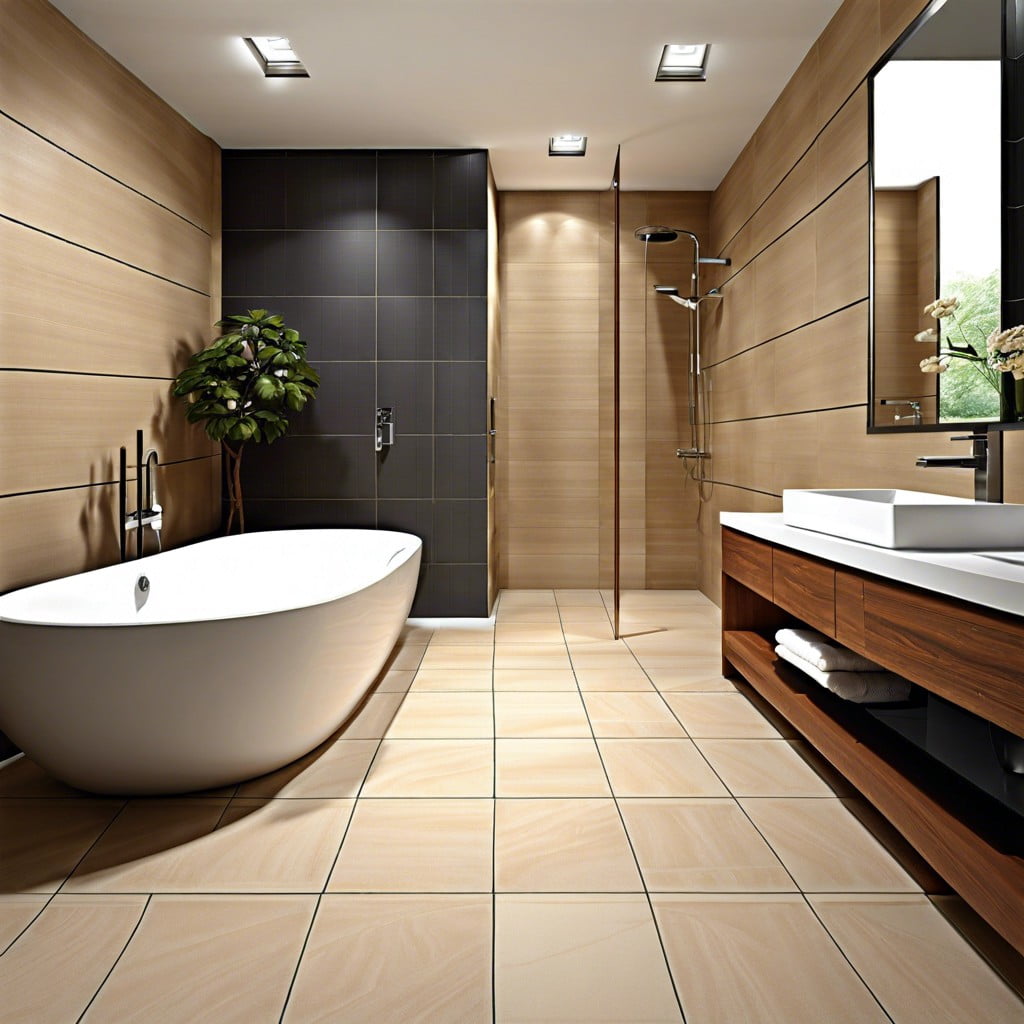Last updated on
Dive into this comparative guide on different vanity depths to gain a comprehensive understanding of their unique advantages and trade-offs.
Key takeaways:
- Vanity depth affects functionality and accessibility of bathroom space
- Shallow vanities (17 inches) create a spacious feel in small bathrooms
- Deeper vanities provide more storage for family bathrooms
- Consider movement freedom, storage solutions, aesthetics, and plumbing compatibility
- Measure carefully and consider traffic flow when shopping for vanities
Understanding Vanity Depth
Vanity depth, often overlooked, plays a pivotal role in the functionality and accessibility of your bathroom space.
Standard depths hover around 21 inches, yet, this one-size-fits-all approach disregards various spatial constraints and user needs.
Shallower vanities, at about 17 inches, can make small bathrooms feel more spacious without sacrificing utility.
On the contrary, deeper options exist, providing ample storage for larger items, ideal for family bathrooms or those who crave extra space for toiletries.
Acknowledging the influence of vanity depth on circulation and comfort is key; too deep, and you’re encroaching on valuable floor space, too shallow, and you might be compromising on storage.
It’s about striking the perfect balance between aesthetics and practicality.
Importance of Vanity Depth in Bathroom Design
Determining the right vanity depth is crucial to maximizing functionality without compromising on style. A too-deep vanity can make a small bathroom feel cramped, while an overly shallow one might fall short on storage needs.
Here are key considerations:
- Movement Freedom: Adequate clearance for foot traffic and door openings ensures comfort and ease of use.
- Storage Solutions: A vanity’s depth must reflect the balance between housing your essentials and preserving open space.
- Proportional Aesthetics: The depth should be in harmony with other bathroom fixtures, contributing to a cohesive look.
- Accessibility: Remember to account for all users – shallow vanities may offer better access for children and individuals with different mobility needs.
- Plumbing Compatibility: Ensuring the sink and plumbing fixtures align with the vanity’s depth avoids unnecessary remodeling costs.
Measuring for Vanity Depth
When preparing to measure for vanity depth, start with the existing space. A common mistake is to measure only the area where the unit will stand; consider door openings, toilet placement, and traffic flow in the room. A vanity that’s too deep can restrict movement and access, while one too shallow may not provide sufficient storage or counter space.
You’ll need a tape measure, note pad, and possibly a second set of hands. Be precise—measure from the wall, not from baseboards or mouldings, as they can skew your numbers. Take note of plumbing location as well; vanity depth must accommodate this without interference.
If you’re dealing with a smaller bathroom, aim for a vanity depth around 20 inches or less. In spacious bathrooms, you might extend up to 24 inches or more. But never forget, comfort in usage trumps size. Far better to have a slightly smaller vanity that promotes a comfortable bathroom experience than an imposing piece that complicates it.
How to Shop for Bathroom Vanities By Depth
When hunting for the perfect bathroom vanity, depth is a pivotal number that can’t be overlooked. A common mistake is selecting a piece that’s aesthetically pleasing yet utterly impractical in the allocated space. Stick to these pointers, and you’ll sidestep such pitfalls:
1. Tailor to Your Space: Measure your bathroom’s dimensions. Know how much room you have before you browse, filtering options by those measurements to save time.
2. Don’t Block Traffic: Consider the swing of doors and the flow of traffic. A vanity that protrudes too far creates a cramped experience.
3. Storage Needs Versus Aesthetics: Balance is key here. More depth translates to more storage, but don’t sacrifice a comfortable space for a few extra drawers.
4. Standard Sizes and Custom Work: Familiarize yourself with standard depths but don’t be afraid to go custom if your bathroom dimensions are unorthodox.
5. Online Tools and Apps: Use retailer’s virtual room planners to visualize vanities in your space before committing.
6. Future Proofing: Think about potential changes in needs or mobility over time; opting for a vanity that’s a bit shallower can make a bathroom more accessible in the long term.
By focusing on the fine print, particularly depth, you’ll ensure your chosen vanity melds seamlessly with your bathroom’s functionality and style.
Other Important Considerations
Navigating the plethora of options can make or break the functionality of your bathroom. Don’t overlook the door swing space; a deeper vanity can hinder the path of an existing door or cabinet. Lighting is equally critical; a shallower depth may mean less obstruction of natural light sources or existing fixtures. Keep in mind the bathroom’s traffic flow and ensure enough clearance for comfortable movement.
Material selection plays a vital role too. Heavier materials may need stronger support, especially in wall-mounted styles. Last but not least, consider the plumbing layout. Existing pipework may limit how creative you can get with depth, potentially requiring additional adjustments during installation. Remember, the goal is harmony between aesthetics and practicality.
FAQ
What is the standard depth of a vanity?
The standard depth of a bathroom vanity typically varies from 20 to 23 inches, with the average falling around 21 inches.
Is 24 too deep for bathroom vanity?
No, 24 is not too deep for a bathroom vanity; it’s within the standard range of bathroom vanity depth.
Can a vanity be 18 deep?
Yes, a bathroom vanity can be 18 inches deep, making it an excellent choice for smaller bathrooms due to its space-saving profile.
What is the average depth of a bathroom sink?
The average depth of a bathroom sink typically ranges between 5 to 8 inches.
How does the depth of a vanity influence the overall dimension of a bathroom?
The depth of a vanity directly affects the overall dimensions of a bathroom by influencing the amount of functional floor space and circulation area available.
Can an excessively deep vanity obstruct bathroom doors or other fixtures?
Yes, an excessively deep vanity can indeed obstruct bathroom doors or other fixtures.
How to select the appropriate vanity depth for a small-size bathroom?
The appropriate vanity depth for a small-size bathroom should be proportional to the size and layout of the bathroom, with slimline models starting at 18 inches, an optimal choice for compact spaces.
Recap
